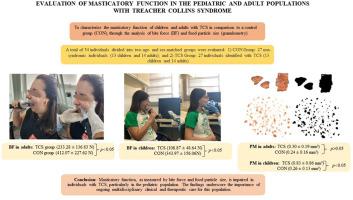Evaluation of masticatory function in the pediatric and adult populations with Treacher Collins syndrome
Q1 Medicine
Journal of oral biology and craniofacial research
Pub Date : 2025-09-06
DOI:10.1016/j.jobcr.2025.08.033
引用次数: 0
Abstract
Introduction
Treacher Collins Syndrome (TCS) is a congenital craniofacial malformation, characterized by zygomatic and mandibular hypoplasia, that may lead to impaired masticatory function.
Objective
To characterize the masticatory function of children and adults with TCS in comparison to a control group (CON).
Materials and methods
Fifty-four participants were divided into two age- and sex-matched groups: 1) CON: 27 non-syndromic participants (13 children and 14 adults); and 2) TCS: 27 participants with TCS (13 children and 14 adults). Masticatory function was assessed using two tests: 1) Bite Force (BF): using a gnathodynamometer; and 2) Granulometry (GM): size of food particles after 20 masticatory cycles of standardized samples.
Results
The mean BF in children with TCS (108.87 ± 48.64 N) was significantly lower than that observed in the CON group (343.97 ± 156.06 N). Similarly, among adults, the BF in the TCS group (233.28 ± 136.83 N) was significantly lower than that of the CON group (412.07 ± 227.62 N). Within the TCS group, children exhibited significantly lower BF than adults, a pattern not observed in the CON group. Children with TCS presented significantly larger particle sizes (0.83 ± 0.86 mm2) than controls (0.26 ± 0.13 mm2). Among adults, no significant differences were observed between groups. Comparisons between age groups showed that children with TCS produced significantly larger particles than adults with TCS.
Conclusion
Masticatory function is impaired in participants with TCS, particularly in the pediatric population. The findings underscore the importance of ongoing multidisciplinary clinical and therapeutic care for this population.

儿童和成人Treacher Collins综合征患者咀嚼功能的评估
treacher Collins综合征(TCS)是一种先天性颅面畸形,以颧骨和下颌发育不全为特征,可导致咀嚼功能受损。目的观察儿童和成人TCS患者的咀嚼功能,并与对照组进行比较。材料和方法54名参与者被分为年龄和性别匹配的两组:1)对照组:27名无综合征参与者(13名儿童和14名成人);2) TCS: 27例TCS患者(13例儿童,14例成人)。采用两项试验评估咀嚼功能:1)咬合力(Bite Force, BF):采用咬功计;2)颗粒测定法(Granulometry, GM):标准化样品经过20个咀嚼循环后的食品颗粒大小。结果TCS患儿平均BF(108.87±48.64 N)明显低于CON组(343.97±156.06 N)。同样,在成人中,TCS组的BF(233.28±136.83 N)显著低于CON组(412.07±227.62 N)。在TCS组中,儿童表现出明显低于成人的BF,这一模式在CON组中没有观察到。TCS患儿颗粒大小(0.83±0.86 mm2)明显大于对照组(0.26±0.13 mm2)。在成年人中,各组之间没有明显差异。年龄组之间的比较表明,患有TCS的儿童产生的颗粒明显大于患有TCS的成人。结论TCS患者的咀嚼功能受损,尤其是儿童。研究结果强调了对这一人群进行多学科临床和治疗护理的重要性。
本文章由计算机程序翻译,如有差异,请以英文原文为准。
求助全文
约1分钟内获得全文
求助全文
来源期刊

Journal of oral biology and craniofacial research
Medicine-Otorhinolaryngology
CiteScore
4.90
自引率
0.00%
发文量
133
审稿时长
167 days
期刊介绍:
Journal of Oral Biology and Craniofacial Research (JOBCR)is the official journal of the Craniofacial Research Foundation (CRF). The journal aims to provide a common platform for both clinical and translational research and to promote interdisciplinary sciences in craniofacial region. JOBCR publishes content that includes diseases, injuries and defects in the head, neck, face, jaws and the hard and soft tissues of the mouth and jaws and face region; diagnosis and medical management of diseases specific to the orofacial tissues and of oral manifestations of systemic diseases; studies on identifying populations at risk of oral disease or in need of specific care, and comparing regional, environmental, social, and access similarities and differences in dental care between populations; diseases of the mouth and related structures like salivary glands, temporomandibular joints, facial muscles and perioral skin; biomedical engineering, tissue engineering and stem cells. The journal publishes reviews, commentaries, peer-reviewed original research articles, short communication, and case reports.
 求助内容:
求助内容: 应助结果提醒方式:
应助结果提醒方式:


